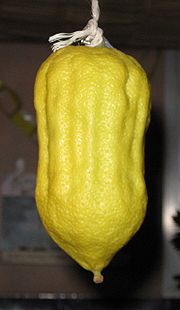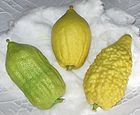- Moroccan citron
-
Moroccan Citron Details Species C. medica The Moroccan sweet citron (Hebrew: אִתְרוֹג מֵרוּקָנֶי) was first described in detail by Professor Henri Chapot, in his article named Un curieux cedrat Marocain (1950).[1] He discovered that the acidity in the more common citrons or lemons, is represented by violet pigmentation on the outer side of the flower blossom, and also by the new buds that are reddish-purplish. The Moroccan citron which is acidless is completely lacking the red colour.
This designation was cited by Webber and Batchelor the editors of the fundamental treatise on citrus, namely The Citrus Industry, which was published by the University of California, Riverside in year 1967.[2]
Contents
Use as etrog
The exact date when the variety came into use for etrog is unknown. According to the local Jewry, it was with them since they were exiled to Morocco after the destruction of the Second Temple. From then on it was highly revered by all the rabbis and communities of Northern Africa, without any interruption or controversy.[3] During time, it got accepted also by Ashkenazi communities all over Europe.[4]
 The Berbers at their etrog plantations.
The Berbers at their etrog plantations.
The precise location of cultivation is at the village Assads in the region of Tarrudant, and a 100 km east of Agadir, as was numerously reported by rabbinical and secular sources.
In 1995, Professor Eliezer E. Goldschmidt together with a delegation of rabbis were hired by a rabbi in Israel, Yosef Shalom Elyashiv, to check out if Morocco is still in the same state of kashrut, and if any grafted etrog is to be found over there. Professor Goldschmidt asked the Moroccan professor of horticulture, namely Mohamed El-Otmani from Agadir, to come along to help.
All together they climbed up the Anti-Atlas canyon where the local Berbers have been cultivating the Moroccan Citron for many centuries, and they were very impressed from the old tradition which is practiced there, finding not one grafted citron tree. (Grafted citrons are not kosher for ritual use on Sukkot, according to halachah.[5])
The delegation presented their finding to Rabbi Elyashiv, who was very happy about the information that the Moroccan wilderness still presents the unbroken lineage, of a non-grafted etrog.
The lack of seeds
However, Schraga Schlomai, a renowned etrog grower[6] recounted the misfortunes of all the used etrog types besides the one he was cultivating, which he claimed to be a descendant of the Balady from Umm al-Fahm.
As to the Yanover and the Corfu he argued based on the booklet from the Salant partners, that since some of them are proven to be grafted, no certification may be granted to the rest, since it is impossible to determine if the non-grafted citrons are not descendents of the grafted ones.
As to the Moroccan and Yemenite he argued, that although there were no grafted trees ever discovered among those kinds, they should be unfit, in light of the differentiation from the Ashkenazi types. The Moroccan citron is allegedly noted for its seedlessness, and the Yemenite for its pulplessness, both are too much different in morphology from the usual yanove and Israeli esrogs.[7]
Acidic-pulp varieties: Non-acidic varieties: - Moroccan citron
- Corsican citron
Pulpless varieties: Related Articles: Citrus • Succade • Hybrid • Grafting • Chimera • Etrog • Sukkoth • Four Species He was than disputed by Rabbi Shmuel David Munk in his responsa "Pe'ath Sadcha" chapter 62, that at least with those who are surely ungrafted, the differentials cannot regret them, since the etrog of one country must not match the morphology of that of another origin.
In 1980 when the market in Brooklyn changed very much in favor of the Moroccan, Rabbi Yekusiel Yehudah Halberstam, the Klausenberger Rebbe, banned the Moroccan citron for religious use.[8] His ruling (printed in 1980) was based on the fact that some of them have no seeds, and seeing that the Shiyurei Kneseth haGedola (Orach Chaim 648) discuses what direction the seeds should be facing to prove their purity, he concluded that an authentic citron should always be seedy.
The seeds of the Moroccan Citron are actually facing utmost vertically as required, and the partial seedlessness cannot be a result of graft, as proven by Dr. Goldschmidt. The only question is about natural hybridization that may have occurred to certain types of citron, some hundreds or thousands of years ago, which is also unlikely in light of the DNA comparison conducted by Dr. Goldschmidt among researchers around the globe.
See also
- History of the Jews in Morocco
- Berber Jews
- Jews and Judaism in Africa
- History of the Jews of Bilad el-Sudan
References
- ^ Rev. Intl. Bot. Appl. Agr. Trop. 30:506–514.
- ^ Available online at The citrus Industry
- ^ Website from North African Rabbi
- Yeshiva Net Episode of Baba Sali witnessed by Rabbi Mordechai Eliyahu.
- ^ HaLevanon 11 no 7 Rabbi Yakov Ettlinger about Moroccan Etrog.
- HaLevanon 13, no 3 Nathan Adler, rabbi of London, and Yakov Sapir about Moroccan etrogs in 1876 - go right away to page 4
- ^ Aruch Hashulchan 648;27
- ^ who republished the "Pri Etz Hadar" booklet that was originally authored by the Salant partners in 1962, see his introduction with the name "Davar el haKorei"
- ^ דבר אל הקורא, שרגא שלומאי, תשכ"ב
- ^ Letters of Shefa Chaim, Vol. 1 No. 34
- The Report by professor Eliezer E. Goldschmidt, in Halichoth Sadeh תשנ"ח, is available for reading in Otzar haChochma.
Wikimedia Foundation. 2010.




